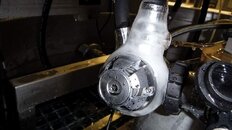KOMPRESSOR
Contributor
Hello from Norway! We've solved this discussion once and for all, at least here. You simply won't find any warm water regs sold here. At least not in any serious shop. and if you do, at least expect them to be thoroughly described as "southern holiday regs".
Anyways, the word around here is that if you expect to do diving in water temps around 50-55F, it's all about sealed cold water regs for you. I can't really say I do much diving in warmer water than that at all, but that's another story.
Now if the air temps are low, below 32F, things are a bit more demanding for you. We arrange OWD courses in the winter occasionally, and it's hardly ever temps above freezing. We make it through with our school gear, and the students do get some extra knowledge about cold water diving this way. Lots of good advice up here in this thread, and I can't say I've found any "bad" advice from anyone. Good! I set my regs a bit tight when it's cold, and open for better flow when I get down. I NEVER(!) test breathe the regs out of water when it's cold! You're supposed to, but hey, are you going to dive or just blow your tanks for nothing after getting all that gear on? That's a choice...
here's my video from a few years back. Enjoy!
YouTube - PADI Ice Diver
(It has been -20F for weeks here now. Getting a bit tired of it. Especially getting my car started every morning with electric heating for an hour before I can even touch it!)
Anyways, the word around here is that if you expect to do diving in water temps around 50-55F, it's all about sealed cold water regs for you. I can't really say I do much diving in warmer water than that at all, but that's another story.
Now if the air temps are low, below 32F, things are a bit more demanding for you. We arrange OWD courses in the winter occasionally, and it's hardly ever temps above freezing. We make it through with our school gear, and the students do get some extra knowledge about cold water diving this way. Lots of good advice up here in this thread, and I can't say I've found any "bad" advice from anyone. Good! I set my regs a bit tight when it's cold, and open for better flow when I get down. I NEVER(!) test breathe the regs out of water when it's cold! You're supposed to, but hey, are you going to dive or just blow your tanks for nothing after getting all that gear on? That's a choice...
here's my video from a few years back. Enjoy!
YouTube - PADI Ice Diver
(It has been -20F for weeks here now. Getting a bit tired of it. Especially getting my car started every morning with electric heating for an hour before I can even touch it!)




